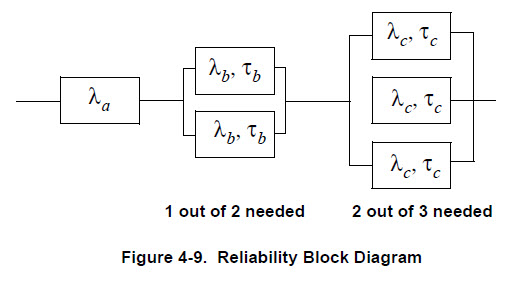Approximation Methods
Provided μ>>λ, the formulae needed to evaluate systems containing redundant sub-systems that can be repaired before the system as a whole fails can be quite simple and easy to use.
The first thing to note is that the general expression for the failure rate of a two-unit active redundant system (using the notation given in Reliability Parameters - Active Redundancy) is given by:

When μ>>λ...s1>>s2, the failure rate given above becomes equal to the constant value -s2, (s1 and s2 are negative quantities), i.e.:
 , which is more conveniently written in the form:
, which is more conveniently written in the form:
This last equation is an extremely useful and well-known result. Other useful results involving two simultaneous failures in a parallel (reliability-wise) system of units may be obtained from it. For example, for a system comprising three units in parallel where two are required for system success, the corresponding expression for system failure rate is:

where the multiplier 3 accounts for the fact that there are three ways of selecting two units from three. For the case where, in a system comprising 10 units, 8 units are required for system success, any combination of 3 (or more) failing together would result in system failure.
For such a system, the failure rate would be given by:

where 3λ3τ2is the (constant) failure rate of a three-unit active parallel system (1 out of 3 needed), and the factor 120 is the number of ways of selecting 3 units from 10.
From the above, it should be apparent that provided each block constituting even the most complicated of block diagrams has an MTTF>>MTTR (θ>>τ), then the failure rate of the system for which the block diagram represents a particular system failure definition, can be written down by inspection of the diagram without the need for any difficult calculations at all. This is more simple than analysing the non-repairable counterpart.
Example
Suppose a failure definition for a particular system is represented by the RBD below:

Then, the system failure rate can be written down by inspection of the diagram. It is:

The corresponding MTTF ( θS) is simply 1/λS.
Had no repairs been possible, then the task of obtaining an expression for system MTTF could be quite complicated. The starting point would be to obtain an expression for system reliability RS(t). Such an expression is given by:

To obtain an expression for the system MTTF, the above expression would have to be integrated from t=0 to t=∞ (not recommended). However, the answer is:

From the foregoing, it should be apparent that analysing quite complicated RBDs is easily accomplished by simply listing the single, then double, then triple failure combinations and assigning to each combination terms similar to those given in expressions (4.12b), (4.12c) and (4.12e). However, when doing this, the remarks in Cautionary Remarks must be kept very much in mind.